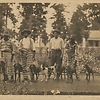Mississippi State Penitentiary (Parchman) Photo Collections...
In January 1901 the state of Mississippi purchased land in Sunflower County for a prison. The Mississippi State Penitentiary, also known as Parchman Farm or simply Parchman, became the main hub for Mississippi's penal system. Parchman Farm was in many ways reminiscent of a gigantic antebellum plantation and operated on the basis of a plan proposed by Governor John M. Stone in 1896. By 1917, Parchman was separated into twelve male camps and one female camp, and racial segregation was considered of paramount importance.
The convicts worked ten hours a day, six days a week, and slept in long, single-story buildings commonly called "cages" that were constructed of bricks and lumber produced on site. Most male prisoners were employed in farming, but some also worked in the brickyard, sawmill, cotton gin, and prison hospital. The female camp produced clothes and bed sheets for the entire farm. On Sundays, the convicts would attend religious services and often formed baseball games between opposing camps.
Because of the remote location and vast size of Parchman Farm, a sophisticated system of walls and fences was considered unnecessary. Prison officials would employ convicts they considered trustworthy as armed guards. These prisoners were known as "trusty guards" or "trusty shooters" and were separated from the general prison population.
These two photograph collections, designated PI/1996.0006 and PI/PEN/P37.4, showcase photographs taken at the Mississippi State Penitentiary in the early twentieth century. They document Parchman facilities and activities from 1914 to the early 1940s.
Read MoreIn January 1901 the state of Mississippi purchased land in Sunflower County for a prison. The Mississippi State Penitentiary, also known as Parchman Farm or simply Parchman, became the main hub for Mississippi's penal system. Parchman Farm was in many ways reminiscent of a gigantic antebellum plantation and operated on the basis of a plan proposed by Governor John M. Stone in 1896. By 1917, Parchman was separated into twelve male camps and one female camp, and racial segregation was considered of paramount importance.
The convicts worked ten hours a day, six days a week, and slept in long, single-story buildings commonly called "cages" that were constructed of bricks and lumber produced on site. Most male prisoners were employed in farming, but some also worked in the brickyard, sawmill, cotton gin, and prison hospital. The female camp produced clothes and bed sheets for the entire farm. On Sundays, the convicts would attend religious services and often formed baseball games between opposing camps.
Because of the remote location and vast size of Parchman Farm, a sophisticated system of walls and fences was considered unnecessary. Prison officials would employ convicts they considered trustworthy as armed guards. These prisoners were known as "trusty guards" or "trusty shooters" and were separated from the general prison population.
These two photograph collections, designated PI/1996.0006 and PI/PEN/P37.4, showcase photographs taken at the Mississippi State Penitentiary in the early twentieth century. They document Parchman facilities and activities from 1914 to the early 1940s.
- « Previous
- Next »

